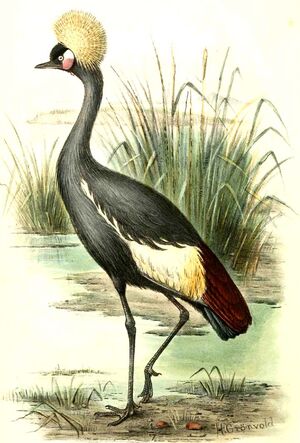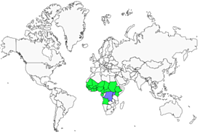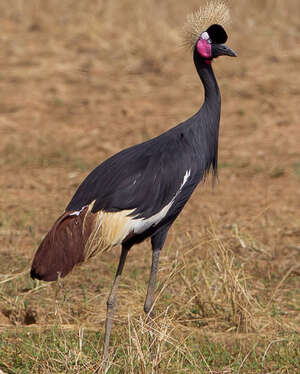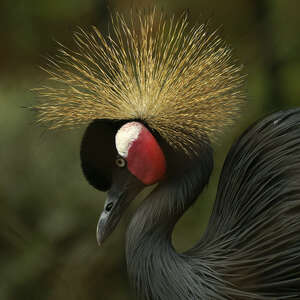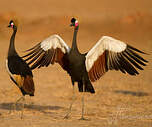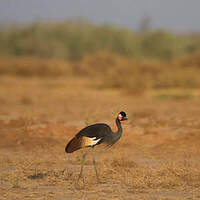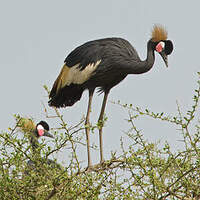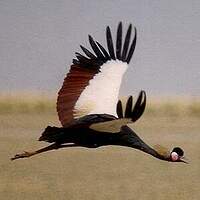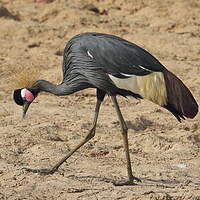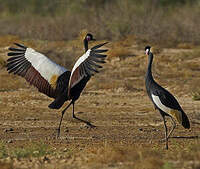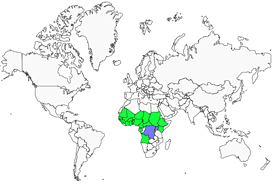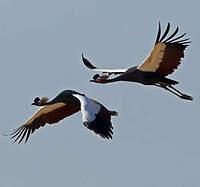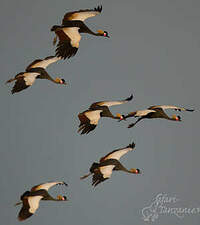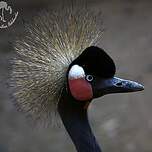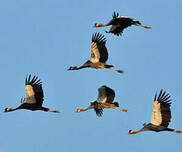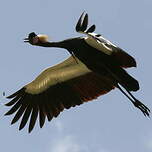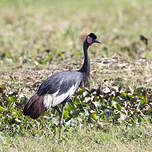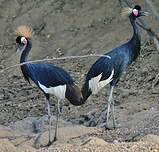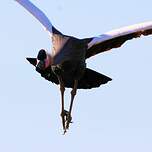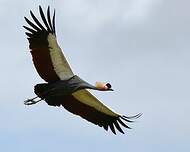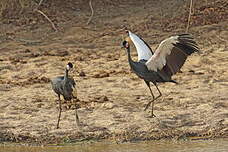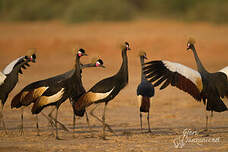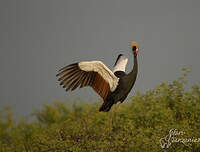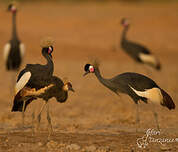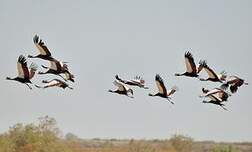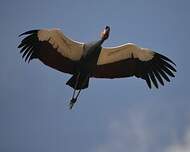Black Crowned Crane
Balearica pavonina - Grue couronnée
Identification
The body plumage is dark grey to black, which gives it its English name of Black Crowned Crane (Black Crowned Crane), in comparison to Grey Crowned Crane, the name of the Royal Crane (Grue royale) with which Black Crowned Crane is often confused, and which has a light grey body.
The remiges (coverts) are white on both sides of the wing, except for the large inner coverts which are tinged yellow. The secondaries are brown, while the primaries are black.
The head shows very contrasting colors: the forehead and the front of the crown, very steep, are black, while the back of the crown has a crown made of long, erect golden-colored feathers.
The cheeks are bare and bicolored, white in their upper half and red in their lower half, these two colors clearly demarcated.
The chin may carry a poorly developed red nodule. This excrescence never reaches the size of that worn by the Royal Crane.
The iris is pale blue.
The beak, long, strong, and straight, as well as the legs, are grey.
The sexes are identical.
The immatures resemble the adults in a duller form, with a less developed crown. Their eyes are brown.
Subspecific information 2 subspecies
- Balearica pavonina pavonina (Senegal and Gambia to Chad)
- Balearica pavonina ceciliae (sw Chad to w Ethiopia to nw Kenya and n Uganda)
Foreign names
- Grue couronnée,
- Grulla coronada cuellinegra,
- grou-coroado-preto,
- Schwarzhals-Kronenkranich,
- feketenyakú koronásdaru,
- Zwarte Kroonkraanvogel,
- Gru coronata nera,
- svart krontrana,
- Svartkrontrane,
- žurav korunkatý,
- jeřáb paví,
- Sort Krontrane,
- kruunukurki,
- grua coronada collnegra,
- koronnik czarny,
- Венценосный журавль,
- カンムリヅル,
- 黑冕鹤,
- 黑冠鶴〔西非冕鶴〕,
Voice song and cries
The Black Crowned Crane vocalises in flight and on the ground during social and nuptial displays. Its call is a resonant wong, sometimes doubled, and lower in pitch than that of the Grey Crowned Crane.
Habitat
Behaviour character trait
Flight
Dietfeeding habits
Reproduction nesting
Geographic range
The Black Crowned Crane and the Royal Crane are two sub-Saharan species whose ranges are disjoint. The Black Crowned Crane can be found distributed along a relatively narrow sub-Saharan band extending from Senegal to Ethiopia and touching the north of the Democratic Republic of Congo, Uganda, and Kenya, where it comes into contact with its congener which replaces it further south.
Threats - protection
IUCN conservation status
concern
in the Wild
threatened
evaluated
The main threats to the Black Crowned Crane are habitat loss due to drainage of wetlands for agriculture, bush fires, overgrazing, industrial and agricultural pollution by pesticides, hunting (the head and wings are used in traditional medicine), and capture of live animals. Oil exploration in and around wetlands can also be a local hazard. Its population has drastically decreased due to all these reasons, so the Black Crowned Crane is classified as vulnerable.
Sources of information
- IOC World Bird List (v14.1), Gill, F and D Donsker (Eds). 2024-04-18.
- Birds of the Gambia and Senegal, Clive Barlow, Tim Wacher, Tony Disley
- Birds of East Africa: Kenya, Tanzania, Uganda, Rwanda, Burundi, Terry Stevenson, John Fanshawe
- BirdLife International, BirdLife International
- Avibase, Lepage Denis
Other sources of interest
 Specification sheet created on
29/07/2023 by Catherine et Bernard Lanneluc
Specification sheet created on
29/07/2023 by Catherine et Bernard LannelucTranslation by AI Oiseaux.net
published: 31-10-2014 - Updated: 08-09-2015
© 1996-2024 Oiseaux.net
- Accipitriformes
- Aegotheliformes
- Anseriformes
- Apodiformes
- Apterygiformes
- Bucerotiformes
- Caprimulgiformes
- Cariamiformes
- Casuariiformes
- Charadriiformes
- Ciconiiformes
- Coliiformes
- Columbiformes
- Coraciiformes
- Cuculiformes
- Eurypygiformes
- Falconiformes
- Galliformes
- Gaviiformes
- Gruiformes
- Leptosomiformes
- Mesitornithiformes
- Musophagiformes
- Nyctibiiformes
- Opisthocomiformes
- Otidiformes
- Passeriformes
- Pelecaniformes
- Phaethontiformes
- Phoenicopteriformes
- Piciformes
- Podargiformes
- Podicipediformes
- Procellariiformes
- Psittaciformes
- Pterocliformes
- Rheiformes
- Sphenisciformes
- Steatornithiformes
- Strigiformes
- Struthioniformes
- Suliformes
- Tinamiformes
- Trogoniformes

